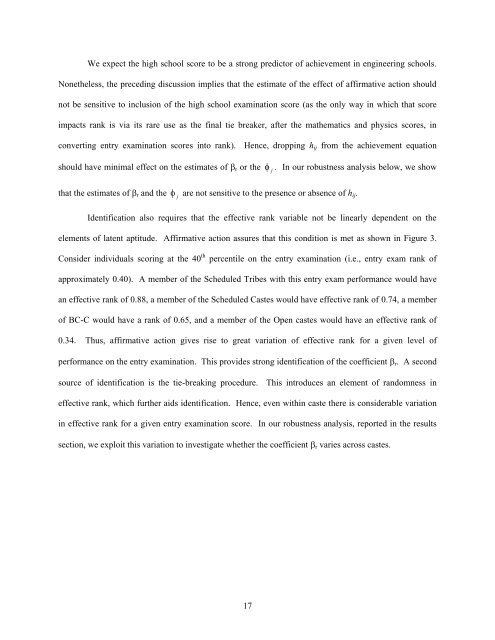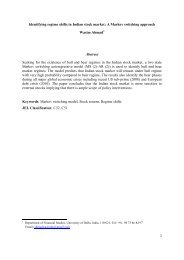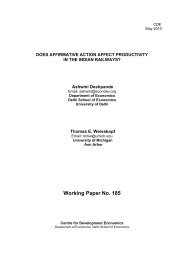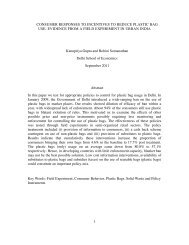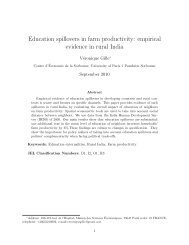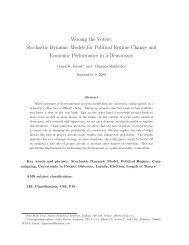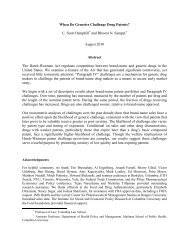Dismantling the Legacy of Caste - Centre For Development Economics
Dismantling the Legacy of Caste - Centre For Development Economics
Dismantling the Legacy of Caste - Centre For Development Economics
Create successful ePaper yourself
Turn your PDF publications into a flip-book with our unique Google optimized e-Paper software.
We expect <strong>the</strong> high school score to be a strong predictor <strong>of</strong> achievement in engineering schools.<br />
None<strong>the</strong>less, <strong>the</strong> preceding discussion implies that <strong>the</strong> estimate <strong>of</strong> <strong>the</strong> effect <strong>of</strong> affirmative action should<br />
not be sensitive to inclusion <strong>of</strong> <strong>the</strong> high school examination score (as <strong>the</strong> only way in which that score<br />
impacts rank is via its rare use as <strong>the</strong> final tie breaker, after <strong>the</strong> ma<strong>the</strong>matics and physics scores, in<br />
converting entry examination scores into rank). Hence, dropping h ij from <strong>the</strong> achievement equation<br />
should have minimal effect on <strong>the</strong> estimates <strong>of</strong> r or <strong>the</strong><br />
that <strong>the</strong> estimates <strong>of</strong> r and <strong>the</strong><br />
<br />
j<br />
. In our robustness analysis below, we show<br />
<br />
j<br />
are not sensitive to <strong>the</strong> presence or absence <strong>of</strong> h ij .<br />
Identification also requires that <strong>the</strong> effective rank variable not be linearly dependent on <strong>the</strong><br />
elements <strong>of</strong> latent aptitude. Affirmative action assures that this condition is met as shown in Figure 3.<br />
Consider individuals scoring at <strong>the</strong> 40 th percentile on <strong>the</strong> entry examination (i.e., entry exam rank <strong>of</strong><br />
approximately 0.40). A member <strong>of</strong> <strong>the</strong> Scheduled Tribes with this entry exam performance would have<br />
an effective rank <strong>of</strong> 0.88, a member <strong>of</strong> <strong>the</strong> Scheduled <strong>Caste</strong>s would have effective rank <strong>of</strong> 0.74, a member<br />
<strong>of</strong> BC-C would have a rank <strong>of</strong> 0.65, and a member <strong>of</strong> <strong>the</strong> Open castes would have an effective rank <strong>of</strong><br />
0.34. Thus, affirmative action gives rise to great variation <strong>of</strong> effective rank for a given level <strong>of</strong><br />
performance on <strong>the</strong> entry examination. This provides strong identification <strong>of</strong> <strong>the</strong> coefficient r . A second<br />
source <strong>of</strong> identification is <strong>the</strong> tie-breaking procedure. This introduces an element <strong>of</strong> randomness in<br />
effective rank, which fur<strong>the</strong>r aids identification. Hence, even within caste <strong>the</strong>re is considerable variation<br />
in effective rank for a given entry examination score. In our robustness analysis, reported in <strong>the</strong> results<br />
section, we exploit this variation to investigate whe<strong>the</strong>r <strong>the</strong> coefficient r varies across castes.<br />
17


